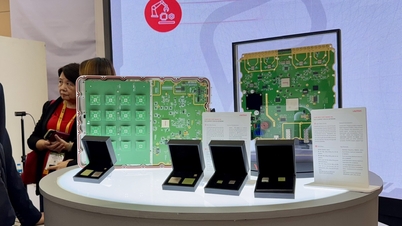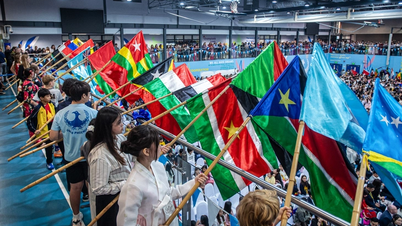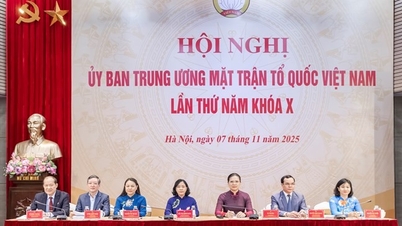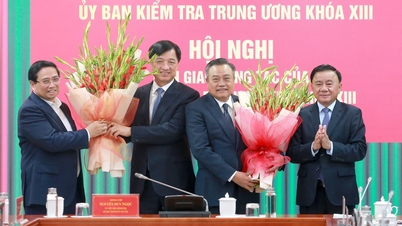On November 4, the Institute of Archaeology - Vietnam Academy of Social Sciences organized an international conference on the Thang Long Imperial Citadel relic site - Achievements and issues after 15 years of research (2011-2025).
The workshop aims to summarize and evaluate the scientific research achievements on the Thang Long Imperial Citadel relic site chaired by the Institute of Imperial Citadel Studies (now the Institute of Archaeology) on the Project of Editing, Researching, Evaluating the Value and Establishing a Scientific Profile of the Thang Long Imperial Citadel relic site over the past 15 years, from 2011 to 2025.
The excavation has "unprecedented" scientific value.
Associate Professor Dr. Bui Minh Tri - former Director of the Institute of Imperial Citadel Studies affirmed that this is a scientific event of special significance, marking 15 years of in-depth research on the Thang Long Imperial Citadel relic site - a World Cultural Heritage of Vietnam.
According to Associate Professor Dr. Bui Minh Tri, the project has achieved many important results:
- Decoding the mystery of the Imperial Palace architecture, clarifying the appearance of the palaces of the Ly - Tran - Le So dynasties, especially Kinh Thien Palace.
- Reconstructing the life of the Thang Long Royal Palace through research and classification of millions of relics, especially royal ceramics, reflecting material and spiritual life and international trade activities.
- Affirming the outstanding global value of heritage, bringing archaeological results from underground closer to the public, creating a foundation for conservation and promoting future values.
Associate Professor Dr. Tong Trung Tin acknowledged that the archaeological excavations at 18 Hoang Dieu (2002-2004) and under the National Assembly House (2008) with a total area of over 30,000 square meters have brought about special scientific discoveries, continuously clarifying the cultural and architectural layers of over 1,300 years of the center of Thang Long Imperial Citadel, from Dai La - Dinh - Tien Le - Ly - Tran - Le So - Mac - Le Trung Hung. He called this an excavation of "unprecedented" scientific value in the history of Vietnamese archaeology.

Associate Professor, Dr. Bui Minh Tri introduced the model of the restoration of Kinh Thien Palace to the delegates.
Mr. Tin said that the outstanding values discovered include:
- The first discovery of architectural relics from the Dai La period, including foundations, wells, sewers... proving the central location of Dai La citadel - the foundation of Thang Long capital mentioned by Ly Thai To in the Proclamation on the transfer of the capital.
- Identifying the architecture of the Dinh - Tien Le period with the unique arrangement of corner columns, affirming that this place was the "Kinh phu" - the second largest center after Hoa Lu.
- Discover the most massive architectural scale of the Ly Dynasty: more than 50 palace foundations, wells, sewers, and surrounding walls, demonstrating the pinnacle of technical planning and construction art, along with the sophisticated Ly ceramic system, proving the prosperous life of the Thang Long royal court.
- The Tran, Le So dynasties and the following periods strongly transformed the space of the capital. In particular, the relics of the Le dynasty (blue and white porcelain, royal porcelain, bronze guns...) reflect the peak of art and the most brilliant period of exporting Vietnamese ceramics.
Turn archaeological research into a driving force for socio-economic development
From the results of "unprecedented" scientific value, Associate Professor Dr. Bui Minh Tri said that this international conference summarizes achievements and opens up new research directions with 3 main groups of problems.
- Decoding and evaluating the architecture of the Imperial Palace in a comparative context with ancient East Asian palaces, in order to determine its value and propose restoration solutions.
- Royal life in history through documents and archaeological relics.
- Economic and cultural exchange of Thang Long with ancient Asian capitals.

Kinh Thien power model.
Professor Bui Minh Tri raised four strategic issues that need to be prioritized:
1. Increase investment in research and heritage restoration, consider archaeology as the foundation, mobilize interdisciplinary (archaeology, architecture, 3D technology) to gradually revive heritage.
2. Building a comprehensive digital database, applying GIS, 3D scanning, and AI to recreate the appearance of the citadel using modern technology, serving research and tourism.
3. Promote scientific publication, compilation and publication of a system of specialized publications for the period 2026-2030 to promote heritage values to the public.
4. Connecting research, conservation, and promotion of the economic value of heritage, aiming to turn Thang Long Imperial Citadel into a "living museum" like the ancient capitals of East Asia.
Dr. Nguyen Thi Hau (University of Social Sciences and Humanities, Ho Chi Minh City) said that York City is a typical example of the harmonious combination of urban archaeology, community archaeology and heritage tourism, turning archaeological research into a driving force for socio-economic development. This success comes from the close coordination between the government, archaeological organizations, universities and local communities.
According to her, the official time of excavation and research of Thang Long Imperial Citadel (2002-2025) is short compared to the existence of this heritage, but it is enough to look back on a journey, evaluate the historical value and position Thang Long Imperial Citadel in the system of Vietnamese cultural heritage.
"With the special value of a world heritage, Thang Long Imperial Citadel can completely learn and adapt the model of York City to suit the conditions of Vietnam. Build a strategy on cultural heritage so that Thang Long Imperial Citadel becomes a living heritage city, not just an archaeological site.
This strategy requires close and synchronous coordination between management agencies, scientists, communities and businesses - towards a common goal: turning archaeological heritage into living heritage in the heart of contemporary urban areas. Developing from heritage and for the community is sustainable development."

3D drawing of the overall architectural form of the Ly Dynasty palace. Photo: Imperial Citadel Research Institute.
Associate Professor Dr. Dao Tuan Thanh (Hanoi National University of Education) emphasized that the application of artificial intelligence in heritage exploitation will open up new development directions for Vietnam's cultural and tourism industry in the digital age. He proposed a number of key solutions:
First: Building "Thang Long Imperial Citadel AI" - an artificial intelligence system based on comprehensive digital data on archaeology, research, artifacts, tourism statistics... When there is big data, AI can forecast tourist trends, advise on exploitation and design suitable tourism and cultural products, and at the same time spread heritage values faster and more sustainably.
Second: Forming a digital ecosystem about Thang Long Imperial Citadel, connecting and digitizing all information about relics, comparing with ancient capitals in the region to clarify the identity and unique historical and cultural values of Thang Long - Hanoi.
Third: Plan for Thang Long Imperial Citadel to become the cultural and tourism industrial center of the Capital, linked with the Old Quarter and Hoan Kiem Lake. It is necessary to focus on creativity and uniqueness in each cultural tourism product, while promoting digitalization, automation and AI application in heritage promotion.
Fourth: Building the Thang Long Imperial Citadel Digital Museum, applying AI in displaying, introducing and interacting with the public. This will be a bridge between heritage and the community, contributing to effective preservation and promotion in the era of globalization.
Fifth: Accelerate the digitization of scientific records of relics and artifacts, creating an input database for "AI Imperial Citadel of Thang Long". This process requires coordination between archaeological and research agencies and information technology experts, combined with multimedia communications to widely promote the heritage.
Source: https://vietnamnet.vn/giai-ma-bi-an-ve-doi-song-hoang-cung-tai-hoang-thanh-thang-long-2459275.html






![[Photo] Da Nang: Hundreds of people join hands to clean up a vital tourist route after storm No. 13](https://vphoto.vietnam.vn/thumb/1200x675/vietnam/resource/IMAGE/2025/11/07/1762491638903_image-3-1353-jpg.webp)
































































































Comment (0)